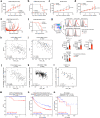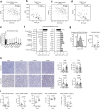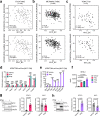Combinatorial immunotherapies overcome MYC-driven immune evasion in triple negative breast cancer
- PMID: 35760778
- PMCID: PMC9237085
- DOI: 10.1038/s41467-022-31238-y
Combinatorial immunotherapies overcome MYC-driven immune evasion in triple negative breast cancer
Erratum in
-
Author Correction: Combinatorial immunotherapies overcome MYC-driven immune evasion in triple negative breast cancer.Nat Commun. 2022 Nov 21;13(1):7140. doi: 10.1038/s41467-022-34570-5. Nat Commun. 2022. PMID: 36414627 Free PMC article. No abstract available.
Abstract
Few patients with triple negative breast cancer (TNBC) benefit from immune checkpoint inhibitors with complete and durable remissions being quite rare. Oncogenes can regulate tumor immune infiltration, however whether oncogenes dictate diminished response to immunotherapy and whether these effects are reversible remains poorly understood. Here, we report that TNBCs with elevated MYC expression are resistant to immune checkpoint inhibitor therapy. Using mouse models and patient data, we show that MYC signaling is associated with low tumor cell PD-L1, low overall immune cell infiltration, and low tumor cell MHC-I expression. Restoring interferon signaling in the tumor increases MHC-I expression. By combining a TLR9 agonist and an agonistic antibody against OX40 with anti-PD-L1, mice experience tumor regression and are protected from new TNBC tumor outgrowth. Our findings demonstrate that MYC-dependent immune evasion is reversible and druggable, and when strategically targeted, may improve outcomes for patients treated with immune checkpoint inhibitors.
© 2022. The Author(s).
Conflict of interest statement
The authors declare no competing interests.
Figures




References
Publication types
MeSH terms
Substances
Grants and funding
LinkOut - more resources
Full Text Sources
Molecular Biology Databases
Research Materials

